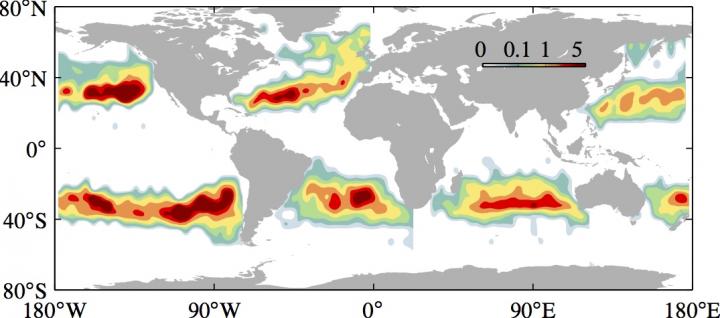New study helps explain how garbage patches form in the world's oceans

This image shows the density of finite-size objects after 1.5 years of evolution starting from a uniform distribution under the combined action of simulated ocean currents and reanalyzed winds. Credit: Beron-Vera, Olascoaga and Lumpkin
A new study on how ocean currents transport floating marine debris is helping to explain how garbage patches form in the world's oceans. Researchers from the University of Miami (UM) Rosenstiel School of Marine and Atmospheric Science and colleagues developed a mathematical model that simulates the motion of small spherical objects floating at the ocean surface.
The researchers feed the model data on currents and winds to simulate the movement of marine debris. The model's results were then compared with data from satellite-tracked surface buoys from the NOAA Global Drifter Program's database.
Data from both anchored buoys and those that become unanchored, or undrogued, over time were used to see how each accumulated in the five ocean gyres over a roughly 20-year timeframe.
“We found that undrogued drifters accumulate in the centers of the gyres precisely where plastic debris accumulate to form the great garbage patches,” said Francisco Beron-Vera, a research associate professor in the UM Rosenstiel School's Department of Atmospheric Sciences and lead author of the study.
“While anchored drifters, which are designed to closely follow water motion, take a much longer time to accumulate in the center of the gyres.”
The study, which takes into account the combined effects of water and wind-induced drag on these objects, found that the accumulation of marine debris in the subtropical gyres is too fast to be due solely to the effect of trade winds that converge in these regions.
“We show that the size and weight of the drifters must be taken into account to fully explain the accumulation,” said Maria Josefina Olascoaga, an associate professor in the UM Rosenstiel School's Department of Ocean Sciences and a co-author of the study.
The model could be used to track shipwrecks, airplane debris, sea ice and pollution among the many practical applications according to the researchers.
###
The study, titled “Inertia-induced accumulation of flotsam in the subtropical gyres,” was published in Geophysical Research Letters. The study's authors are: Francisco Beron-Vera, Maria Josefina Olascoaga, and Rick Lumpkin from the NOAA Atlantic Oceanic and Meteorological Laboratory (AOML).
The Gulf of Mexico Research Initiative, NOAA/AOML, and the Cooperative Institute for Marine and Atmospheric Studies (CIMAS), a joint enterprise between NOAA/AOML and the University of Miami Rosenstiel School, supported the work.
About the University of Miami's Rosenstiel School
The University of Miami is one of the largest private research institutions in the southeastern United States. The University's mission is to provide quality education, attract and retain outstanding students, support the faculty and their research, and build an endowment for University initiatives. Founded in the 1940's, the Rosenstiel School of Marine & Atmospheric Science has grown into one of the world's premier marine and atmospheric research institutions. Offering dynamic interdisciplinary academics, the Rosenstiel School is dedicated to helping communities to better understand the planet, participating in the establishment of environmental policies, and aiding in the improvement of society and quality of life. For more information, visit: http://www.
Media Contact
All latest news from the category: Earth Sciences
Earth Sciences (also referred to as Geosciences), which deals with basic issues surrounding our planet, plays a vital role in the area of energy and raw materials supply.
Earth Sciences comprises subjects such as geology, geography, geological informatics, paleontology, mineralogy, petrography, crystallography, geophysics, geodesy, glaciology, cartography, photogrammetry, meteorology and seismology, early-warning systems, earthquake research and polar research.
Newest articles

High-energy-density aqueous battery based on halogen multi-electron transfer
Traditional non-aqueous lithium-ion batteries have a high energy density, but their safety is compromised due to the flammable organic electrolytes they utilize. Aqueous batteries use water as the solvent for…

First-ever combined heart pump and pig kidney transplant
…gives new hope to patient with terminal illness. Surgeons at NYU Langone Health performed the first-ever combined mechanical heart pump and gene-edited pig kidney transplant surgery in a 54-year-old woman…

Biophysics: Testing how well biomarkers work
LMU researchers have developed a method to determine how reliably target proteins can be labeled using super-resolution fluorescence microscopy. Modern microscopy techniques make it possible to examine the inner workings…





















